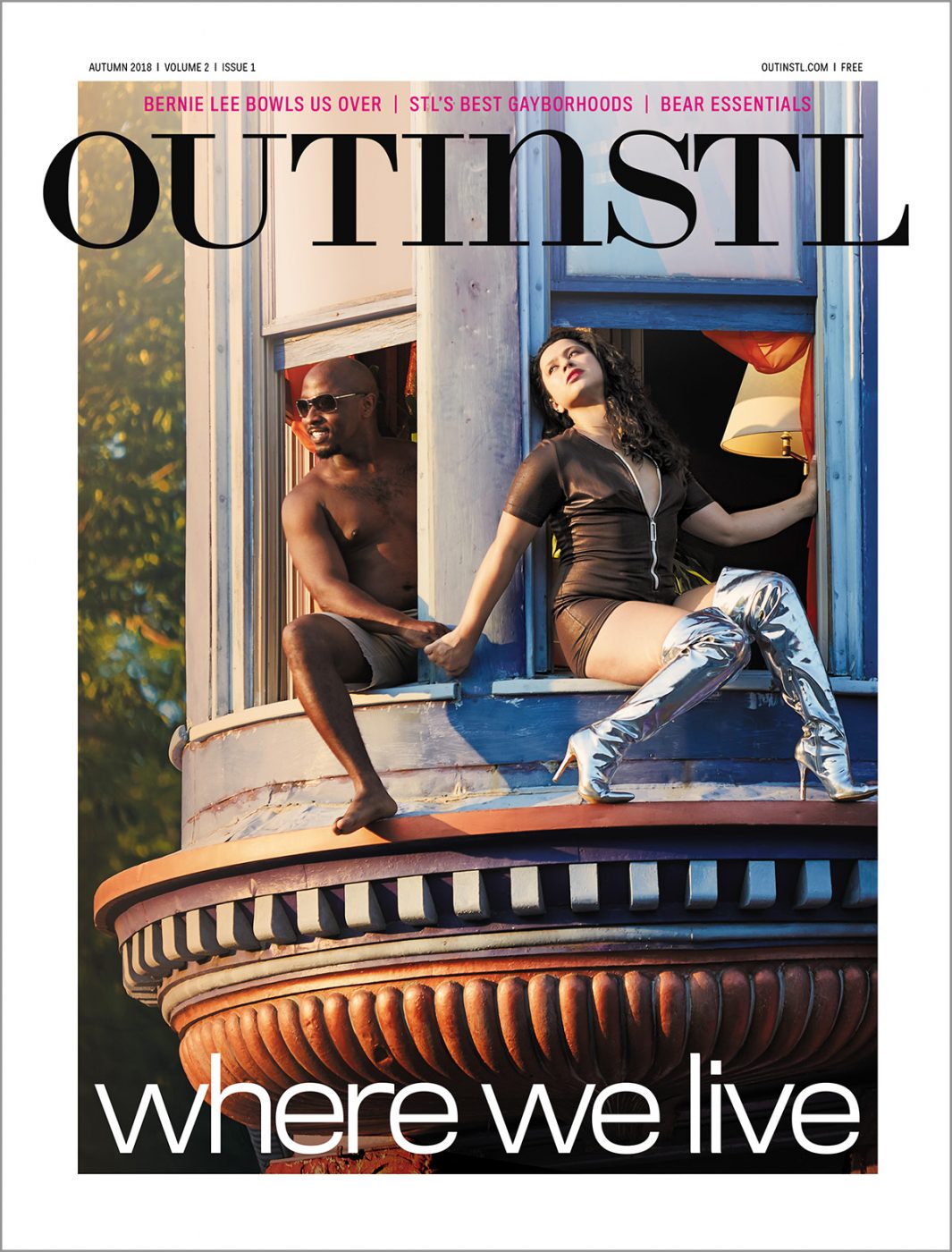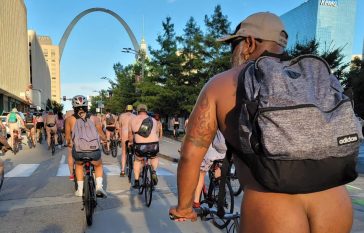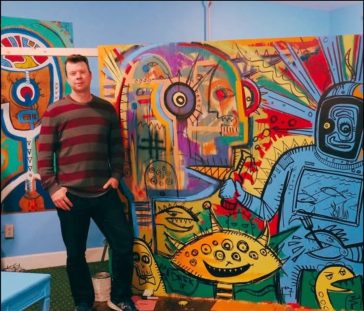There was some grumbling in conservative Jefferson County when the 2016 DeSoto Christmas Parade was slated to include the county’s drag bar, Rumors on Ice. Among the garden-variety homophobic comments posted to the event’s Facebook page, one stuck with me: “Go back to the Central West End.”
The remark amused me on a couple of levels. One: the dated idea of the Central West End being synonymous with “gay” — a concept that hit its peak in the seventies and eighties. Second, I can’t help but think it would blow this troll’s mind to learn that his Jefferson County community is home to more drag than the Central West End today.
While residing in concentrated LGBTQ neighborhoods was once a necessity for those wanting to live openly, these days it’s more of a preference, one factor to be weighed alongside other area amenities. Still, many of us seem to cluster in our preferred enclaves, whether it’s because we share similar tastes, we like living where the
action is, or both.
We asked our readers to tell us what St. Louis area neighborhood was the best “gayborhood,” and your top five picks have some similarities. Three are near the Mississippi River, four out of the five are in the city, all have impressive historic housing stock, all have LGBTQ businesses in walkable proximity to residences, and all serve as magnets for LGBTQ visitors from throughout the region and beyond.
Most importantly for the purposes of this poll, all of these neighborhoods have passionate supporters.

Soulard’s gorgeous brick homes provide a backdrop to heavy-duty partying. Photo by Chris Andoe.
5. Soulard
Called “The Island” by many of its cocktail-loving, golf-cart driving residents because of the way the river and highways cut it off from everywhere else, Soulard is the oldest intact neighborhood in the city, as well as St. Louis’ own French Quarter. The area has had a sizable LGBTQ population since at least the seventies, when several bars catering to our community opened up. At that time many of the historic brick homes were abandoned, and all were going cheap. Today, property values in Soulard are among the city’s highest.
St. Louis is a drinking town, but nowhere is alcohol more central to the culture than in Soulard, with its countless corner taverns, tucked-away patios and of course its massive Mardi Gras celebration. Once, leaving brunch at Nadine’s, I saw three golf carts in a row and was trying to determine which one belonged to my friend. “This one must be it,” I proclaimed. “It has beer bottles in the cup holders.” We then discovered all three had beer bottles in the cup holders.
Saturday mornings are the best time for shopping and socializing at Soulard Farmers’ Market. Grab a cheap and delicious Bloody Mary at Julia’s Market Cafe and peruse the offerings while stopping to visit with friends doing the same. Any evening of the week you can find good conversation just by walking down the street, where bars and restaurants have tables lining the uneven brick sidewalks and residents enjoy libations on their front stoops.
Of all the neighborhoods chosen by readers, none comes close to honoring its dead like Soulard. Examples include Midnight Annie, a drag queen who long performed at Clementine’s and whose remains were entombed in the wall there, and the recent funeral march held for murdered Bastille bartender Peyton Keene, where hundreds marched, played instruments and rode in adorned vehicles and golf carts while bars along the route offered free shots to passing mourners.
An island in the heart of everything, Soulard is among the most interesting districts in St. Louis, and feels like home, even to many of us who don’t live there.

Nathaniel Lucena has found happiness in Carondelet’s growing LGBTQ community. Photo by Nathaniel Lucena.
4. Carondelet/Patch
Founded in 1767 by French-speaking settlers, and annexed by St. Louis in 1870, Soulard’s scrappy and much more diverse down-river sister is seeing a resurgence with rehabbers drawn to the historic housing stock, some of which is among the oldest in the region but remains surprisingly affordable. From the workers in the industrial businesses along the riverfront to the homeowners restoring their domiciles brick by brick, this is a place where skilled people use their hands.
The community’s roots in this area, at the southern tip of the city, run deep. Greg Yogi Thomas, whose family has resided in the neighborhood for generations, remembers a trans woman who lived openly on his block for much of the seventies.
“Did people leave her alone?” I asked him.
“Hell yeah they did! She’d kick your ass!” Thomas replied.
South Broadway has had gay and lesbian bars going back decades, and the two current LGBTQ bars, Bar: PM and Hummel’s, flank “Queen of Country” Bonnie Blake’s antique shop. Steven Louis Brawley of the St. Louis LGBT History Project believes that Blake, 90, is the world’s oldest performing drag queen.
Brawley has concerns about the increasing buzz around South Broadway. “St. Louis’s ‘gayborhoods’ have always been on the margins, and our local LGBTQIA+ community needs more recognition for its many contributions to the revitalization of historic neighborhoods such as Benton Park, the Central West End, Lafayette Square, South Grand, Soulard, etc.,” he says. “Many of our pioneers and elders, including Bonnie, have settled where they feel at home, not because it’s trendy or fashionable. Gayborhoods are places to work, play, and live. Sadly that is a hard trifecta to sustain.”
Read more about Carondelet/Patch in K. Templeton’s “Boo On Broadway” piece in this issue’s nightlife section. The story focuses on a street fair that Bar: PM is throwing in October.

Jason Brooks and Rob Cook make the most of their Alton porch with friends Kage Black and Terrence Stokes. Photo by Chris Andoe.
3. Alton
While the Mississippi River that passes by St. Louis is a workhorse, filled with gigantic barges, a swift current and dangerous debris, twenty miles north it feels more like a lake, with broader width, numerous islands and recreational watercraft. Situated on dramatic bluffs rising high above it all is picturesque Alton, Illinois. Known as one of the most haunted towns in America, I’ve also dubbed it “The Bi-Muda Triangle” (see “Navigating the Weirdness of Alton, Illinois” on outinstl.com), thanks to the town’s penchant for bisexual activity.
The area is rich with outdoor activities, from the marina on the riverfront to the famed Great River Road, where you can drive or bicycle alongside the bluffs for miles in what’s been called one of the most scenic drives in America. Hiking, fishing and ziplining options are available, in addition to numerous wineries.
It was Alton’s marvelous (and shockingly affordable) neighborhoods that lured Kevin Dyer to move here from Old Town Florissant in 2014.
Dyer lives in a circa 1865 elegant Italianate-style home on Christian Hill, a beautiful area defined by steep streets and sweeping views. Like the famously haunted town itself, many homes in Alton have their secrets. In the case of Dyer’s home, so did the man who built it.
“This house and the one across the street were built by Alton architect Lucas Pfeiffenberger, who played an important role in local history,” Dyer begins. “This house has a crawl space between the first and second level that was used for hiding soldiers from the Confederate prison to sneak them out of Alton. The house across the street, which belonged to the best friend of the man who built my house, has a secret passageway from the basement to the garden shed that was used as part of the Underground Railroad to smuggle slaves through Alton.”
The ruggedly handsome Jason Brooks lives in the nearby Middletown Historic District and surveys the city’s goings on from behind the white picket fence in front of his charming two-story, circa 1871 wood-frame home. On a recent Sunday afternoon, he’s on his front porch, conversing with his partner and a couple of friends, when he stops to take notice of an attractive guy walking towards Schwegel’s, a full-service corner grocer that’s a throwback to days gone by. Brooks refers to the blocks around him as “a mini-gayborhood.”
“There are so many of us that live within just blocks of each other. Seven or eight I can just think of off the top of my head within just three blocks of me,” Brooks says.
When the sun goes down, the party kicks off at Bubby & Sissy’s, the LGBTQ bar where Brooks works. Expect a packed dance floor downstairs, a dazzling drag show upstairs and great conversation on the patio with an amazing cross-section of open-minded people.
A 45-minute commute to downtown St. Louis, Alton may not be the best fit for those with city-centered lives or for those who require constant stimulation. But for those who can surrender to the rhythm, this captivating jewel of a town gets in your blood and has plenty to offer.
2. The Grove
In the 1990s the Manchester strip was a mile of boarded-up buildings climaxing with Attitudes, Novak’s and — who could forget — Grandma’s Rainbow’s End. Today, LGBTQ establishments in or immediately outside its borders include PrideCenter (the region’s LGBTQ center and home of Pride St. Louis), Attitudes, Just John, Rehab, the Monocle and the behemoth JJ’s Clubhouse. Many mainstream businesses and venues have also taken hold in the Grove, creating a vibrant, walkable mile illuminated by neon signs hanging over the street demarking the district’s entrances.
In addition to the venues, the neighborhood hosts large street events including GroveFest and the World Naked Bike Ride. But there’s more than meets the eye to this festivity factory, especially at Just John. Pride St. Louis’s Todd Alan is among the many influential people who frequent Just John, sometimes even setting his laptop upon the bar and working there. He notes that Just John raises a tremendous amount of money for the community.
“Last year Thirst For Life raised $12,500, which was more than all other participating bars combined. They also have done events for Pride, Team St Louis, GLASS, GMC, Gateway Pet Guardians, Mullen Day Foundation.” Alan explains. “We are actually lucky in St. Louis to have a lot of generous bar owners in Just John, Rehab and Bar: PM.”
With the area’s boom in high-end housing, with both expensive single-family rehabs and big new multi-family complexes springing up in the neighborhood, some people worry our businesses might be pushed out. Only time will tell, but right now the Grove has never been hotter. Despite the fact fewer of us live within its boundaries than some of the other top neighborhoods, both commercially and in terms of influence, the Grove’s Manchester strip is widely recognized as the region’s most high-profile “gayborhood.”

MoKaBe’ s Coffeehouse has long been a hub for activism in Tower Grove South. Photo by Chris Andoe.
1. Tower Grove South
You would be hard pressed to find a more well-rounded neighborhood for LGBTQ people than Tower Grove South. Want a lesbian-owned social-justice-oriented coffee shop? OK! A drag bar within stumbling distance of your door? Grab your dollars! An LGBTQ-focused twelve-step program? Step right up. Endless Instagram-worthy international food options, food trucks, and an all-night diner? A buffet of options! Affirming, rainbow-flag-flying churches? Praise! A place to buy that last-minute sex toy, or get a replacement key for your handcuffs? Take your pick, and bring your trick! Neighbors who broadcast their liberal beliefs on yard placards? More good signs! Your own world-class pride festival, attracting upwards of 10,000 to your own neighborhood park? Well aren’t you precious? And in the right place!
Beginning in the 1970s and increasing throughout the 1990s, many in our community migrated from the Central West End to south city, and Tower Grove Park was and remains the epicenter of our St. Louis settlement. Tower Grove South is such a multicultural liberal bastion, even its Alderwoman Megan-Ellyia Green is frequently on the streets during major protests, a fact that’s even caught the attention of the New York Times.
Living in close proximity to so many people you know, the neighborhood lends itself to the impromptu. Walking my dog, I’ve been invited to last-minute barbecues, picnics, pool parties and, yes, protests. Even the dead of winter can be fun; a snow day that shut down the city in 2017 inspired a big group of us to take over Friendly’s.
With all the cyclists, dog walkers, people doing yoga in the park, and fit, shirtless joggers, Tower Grove South is teeming with active residents. With all it has to offer, it’s no surprise readers voted it the Top LGBTQ Neighborhood in St. Louis.

Timothy J. Duggan practices yoga in front of the Tower Grove Farmers Market. Photo by Chris Andoe.
Zooming Out
In the grand scheme of things, neighborhood boundaries in St. Louis are somewhat arbitrary. While the cosmopolitan Central West End has no regular drag shows, stroll across a short bridge and you’ll find them several nights a week in the Grove. Similarly, south city, which encompasses many of the highest-ranking LGBT neighborhoods, largely operates as one ecosystem rather than semi-autonomous districts — and a whopping 67 percent of respondents to our poll voted for city neighborhoods south of Interstate 64. You can happily enjoy the delights of Tower Grove South even as you live one block away in Tower Grove East — or even a bit further east in Fox Park. There are enough LGBTQ-friendly businesses, and friendly neighbors, to go around.
That said, we’re glad to bestow bragging rights upon some of the enclaves where it’s easiest to surround yourself with “family.” And for everyone else, isn’t it nice to know we can find welcoming neighbors throughout the St. Louis area — and even in Jefferson County?
Rumors on Ice owner Dave Sassman tells me that those who made a stink about the club participating in the parade succeeded in one thing only: galvanizing the local community to stand up in support of his business and patrons.
“What was funny is it really backfired on them because more people supported us, enjoyed our float and saw nothing wrong with it,” he says. “We actually won ‘best float’ in the parade that year.”
I surmise that “Central West End” wasn’t merely a geographical location in the mind of the Facebook troll, but was an idea of a worldly, urbane place where those he considered “weird” would be readily accepted. But rather than sticking to the Central West End, we’ve made the entire region a bit more like it.
Chris Andoe is the editor in chief of Out in St. Louis and the author of Delusions of Grandeur. He’s currently married to Tower Grove South, but flaunts his torrid affair with Alton.



